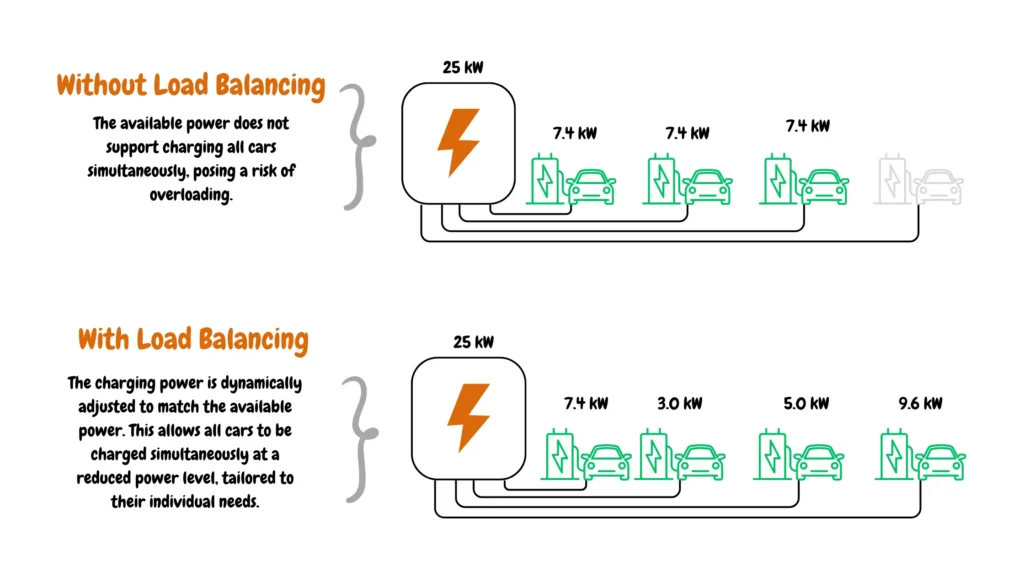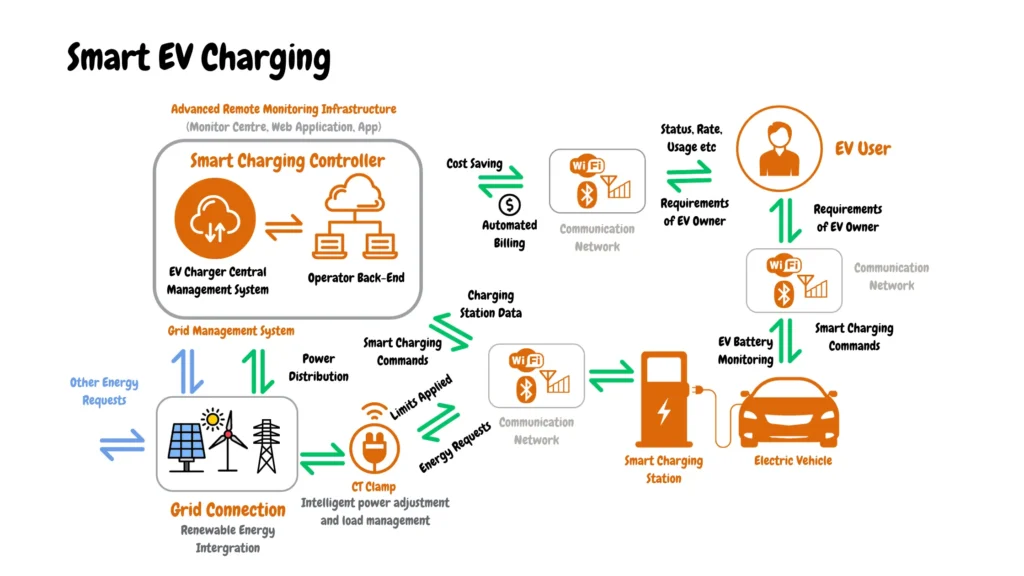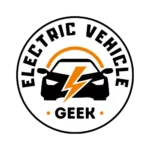EV charging load management is a process by which an electrical load management system controls how much electricity each EV charging station gets when connected to the same electric grid system or circuit.

Homeowners or businesses mainly use it with multiple EVs and chargers; a smart charging ecosystem is built into their EV charging environment that controls electricity flow to each EV charger without overloading the electrical systems.
Smart Load Management for Home Owners with Multiple EVs
For homeowners looking for a solution to EV charging load management, an electrician can install a CT Clamp that connects your smart EV chargers with the grid management system, as shown in the infographics image below; they can offer advice on whether the EV Charging load management should occur at the power circuit, panel, building, or the utility transformer level depending on your home electrical set-up and load.

An EV Charger installer can also recommend the purchase of a smart EV Home charger that offers EV load scheduling features, allowing the homeowner to set charging times during which charging can occur.
EV load scheduling allows the homeowner to take advantage of off-peak times, where they can schedule the charger to start charging during off-peak hours and avoid peak hours, saving their energy costs.
For an optimized smart load management for homeowners with multiple EVs, we recommend EV load management functionality using a CT Clamp and a smart EV charger for load scheduling to co-occur.
How Can Home Owners Implement EV Charging Load Management?
Homeowners can purchase a smart EV Charger that uses OCPP (Open Charge Point Protocol) to dynamically balance the power distribution on their EV charger, there are three ways homeowners can implement EV Charging load management in their EV Charging set-up: Static load management (equally distributed load sharing, first-in, first-charged load sharing), dynamic load management, or Adaptive load management.
Static Load Management.
For homeowners with multiple EVs looking for a budget-friendly solution to charging their EVs, we recommend static load management that can be done through adjustable setpoints to their smart EV chargers or splitting power for dual points smart EV charging stations.
Static load management can be implemented by equally distributing power to the chargers depending on how many amps are available and how many smart EV chargers are used; the maximum limits per smart EV charger and the total load limits are balanced.
We recommend using a static load management where a balanced EV charging environment is balanced, for example, when the needs of an EV are unknown or when all EVs in the home have an equal priority to charging.
Dynamic Load Management.
Dynamic load management is useful where the homeowners have EVs with different. Onboard chargers and battery capacities, there are two methods of dynamic load management: adaptive and dynamic load management.
Dynamic load management involves creating a digital twin of the electrical system through the CT-Clamp or the smart charger to automatically manage and adjust the power available for charging.
Homeowners can use a CT Clamp for intelligent power adjustment and load management. This will allow the CT Clamp to monitor the EV chargers, and the smart charging controller will adjust the real-time power output to stay below the setpoint. On dynamic load management, the CT Clamp will evenly divide the power among the EV Chargers or restrict the last plugged EV until the first plugged EV is fully charged, preventing overlading and creating a balanced charging environment.
Adaptive Load Management.
Adaptive load management is advanced dynamic load management that leverages the use of a CT Clamp or a smart EV charger to control the amount of charge that flows to the EVs depending on the EV charging requirements; the CT Clamp and the smart EV charger can apply limits depending on the vehicle requirement such as onboard charger requirements and state of the charger.
An adaptive load management home set-up employs maximum setpoints and continuously monitors active charging sessions to access the charging requirements of connected smart EV chargers; the CT Clamp and smart EV chargers throttle the power, optimizing the overall load by considering individual EV load requirements and charging characteristics.
Do homeowners need load management for EV chargers?
Yes, although single and multi-use homes with only one or two EV chargers load management can be handled by the circuit breaker, single and multi-use homes can benefit from a load management system when they need a smart EV charging set-up.

Some advantages that single and multi-use homes can derive from a smart EV charging set-up with an EV energy management system include:
Electrical infrastructure protection.
A load management system is beneficial in protecting your home’s electrical infrastructure. The U.S. Fire Administration recommends that EV owners avoid overcharging their EVs to protect a property’s electrical infrastructure; using an EV energy management system in your home manages your EV charging to prevent charging your EV at home, especially at night past their full capacity, which can cause overheating leading to fires.
Prevent Overloading of your home electrical system.
Most residential homes have a typical pattern where the preference is to leave the EVs plugged in and charging overnight; an EV charging load management is necessary if you don’t necessarily want the EVs to charge at full power at the same time, as this can lead to overloading your home electrical system.
To prevent the Overloading of your home electrical system, we recommend using dynamic load management of your EVs, which is helpful in scheduled charging and more useful in a small car park to prevent Overloading of the electrical system when multiple EVs are plugged and at full power, which can cause power outages and damage to your home electrical infrastructure.
Reduce Your Home EV Energy Consumption
An ordinary circuit breaker is great to prevent overloading your electrical consumption, but it can’t help when it comes to reducing your energy consumption; this is where EV charging load management devices such as a CT Clamp come into play; using dynamic load management the CT Clamp can reduce the overall energy consumption of the charging system.
We also advise homeowners looking forward to adding EV charging stations to install a load management control device to manage energy use; the load management control device installed on the circuit, panel, building, or utility transformer level to help manage energy use on the home more efficiently.
The big problem with owning an EV for homeowners is that EVs increase home power consumption by 25-35%.
Owners can use EV load management systems to reduce energy consumption and costs. An intelligent load management system installed in a home will allow the homeowner to schedule his charging during off-peak hours, which is then applied by the EV load management system to reduce energy costs.
EV load management can also help homeowners reduce their energy consumption by allowing homeowners with an EV charger installed to adjust their consumption based on real-time information from the grid relayed to them through a demand response program, giving them complete control of their charging processes to coincide with low-demand periods.
Integrating Solar Power with Electric Vehicle Charging
For homeowners who have or are looking forward to integrating solar power with electric vehicle charging, having an EV charging load management is essential in their quest to use renewable energy to power their solar-powered EV chargers to help support renewable energy development and reduce their carbon footprint.
EV load management when using solar power can be used when the power output from the solar (PV) is larger than utility grid power (during daytime). The PV power is given a higher priority than the grid power; also, during the night, when PV output is smaller than the grid power, the grid or PV stored power will be given a higher priority.

James Ndungu is a certified EV charger installer with over five years of experience in EVSE selection, permitting, and installation. He holds advanced credentials, including certification from the Electric Vehicle Infrastructure Training Program (EVITP) and specialized training in EV charging equipment and installation, as well as diplomas in EV Technology and Engineering Fundamentals of EVs. Since 2021, James has tested dozens of EV chargers and accessories, sharing expert insights into the latest EV charging technologies.







